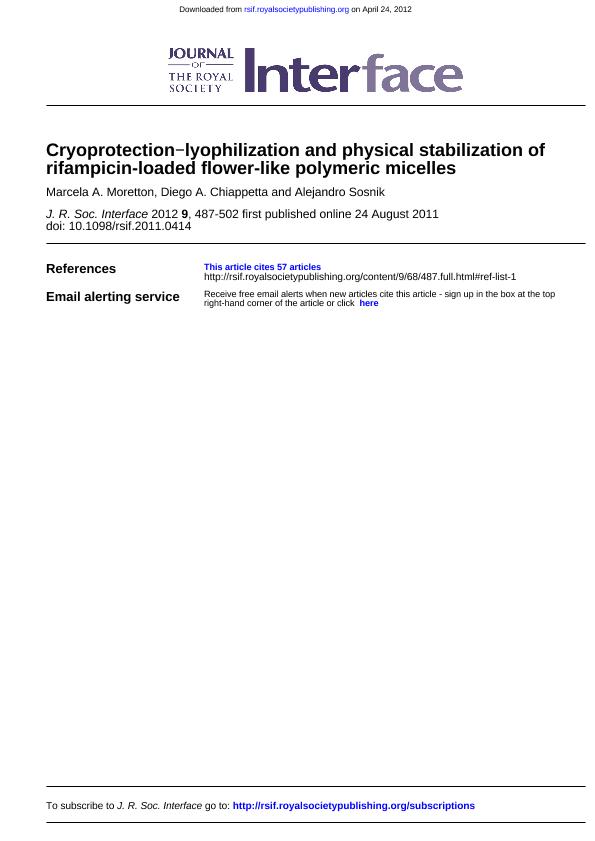Mostrar el registro sencillo del ítem
dc.contributor.author
Moretton, Marcela Analía

dc.contributor.author
Chiappetta, Diego Andrés

dc.contributor.author
Sosnik, Alejandro Dario

dc.date.available
2023-05-17T18:03:18Z
dc.date.issued
2012-08
dc.identifier.citation
Moretton, Marcela Analía; Chiappetta, Diego Andrés; Sosnik, Alejandro Dario; Cryoprotection–lyophilization and physical stabilization of rifampicin-loaded flower-like polymeric micelles; The Royal Society; Journal of the Royal Society Interface; 9; 68; 8-2012; 487-502
dc.identifier.issn
1742-5689
dc.identifier.uri
http://hdl.handle.net/11336/197841
dc.description.abstract
Rifampicin-loaded poly(ε-caprolactone)-b-poly(ethylene glycol)-poly(ε-caprolactone) flower-like polymeric micelles display low aqueous physical stability over time and undergo substantial secondary aggregation. To improve their physical stability, the lyoprotection- lyophilization process was thoroughly characterized. The preliminary cryoprotectant performance of mono- and disaccharides (e.g. maltose, glucose), hydroxypropyl-β-cyclodextrin (HPβCD) and poly(ethylene glycol) (PEG) of different molecular weights was assessed in freeze-thawing assays at -20°C, -80°C and -196°C. The size and size distribution of the micelles at the different stages were measured by dynamic light scattering (DLS). A cryoprotectant factor (fc) was determined by taking the ratio between the size immediately after the addition of the cryoprotectant and the size after the preliminary freeze-thawing assay. The benefit of a synergistic cryoprotection by means of saccharide/ PEG mixtures was also assessed. Glucose (1 : 20), maltose (1 : 20), HPβCD (1 : 5) and glucose or maltose mixtures with PEG3350 (1 : 20) (copolymer:cryoprotectant weight ratio) were the most effective systems to protect 1 per cent micellar systems. Conversely, only HPβCD (1 : 5) cryoprotected more concentrated drug-loaded micelles (4% and 6%). Then, those micelle/ cryoprotectant systems that displayed fc values smaller than 2 were freeze-dried. The morphology of freeze-dried powders was characterized by scanning electron microscopy and atomic force microscopy and the residual water content analysed by the Karl Fisher method. The HPβCD-added lyophilisates were brittle porous cakes (residual water was between 0.8% and 3%), easily redispersable in water to form transparent systems with a minimal increase in the micellar size, as determined by DLS.
dc.format
application/pdf
dc.language.iso
eng
dc.publisher
The Royal Society

dc.rights
info:eu-repo/semantics/openAccess
dc.rights.uri
https://creativecommons.org/licenses/by-nc-sa/2.5/ar/
dc.subject
CRYOPROTECTION/ LYOPHILIZATION
dc.subject
PHYSICAL STABILIZATION
dc.subject
RIFAMPICIN-LOADED FLOWER-LIKE POLYMERIC MICELLES
dc.subject.classification
Otras Nanotecnología

dc.subject.classification
Nanotecnología

dc.subject.classification
INGENIERÍAS Y TECNOLOGÍAS

dc.title
Cryoprotection–lyophilization and physical stabilization of rifampicin-loaded flower-like polymeric micelles
dc.type
info:eu-repo/semantics/article
dc.type
info:ar-repo/semantics/artículo
dc.type
info:eu-repo/semantics/publishedVersion
dc.date.updated
2023-05-09T14:40:05Z
dc.journal.volume
9
dc.journal.number
68
dc.journal.pagination
487-502
dc.journal.pais
Reino Unido

dc.journal.ciudad
Londres
dc.description.fil
Fil: Moretton, Marcela Analía. Universidad de Buenos Aires. Facultad de Farmacia y Bioquímica. Departamento de Tecnología Farmacéutica; Argentina. Consejo Nacional de Investigaciones Científicas y Técnicas; Argentina
dc.description.fil
Fil: Chiappetta, Diego Andrés. Universidad de Buenos Aires. Facultad de Farmacia y Bioquímica. Departamento de Tecnología Farmacéutica; Argentina. Consejo Nacional de Investigaciones Científicas y Técnicas; Argentina
dc.description.fil
Fil: Sosnik, Alejandro Dario. Universidad de Buenos Aires. Facultad de Farmacia y Bioquímica. Departamento de Tecnología Farmacéutica; Argentina. Consejo Nacional de Investigaciones Científicas y Técnicas; Argentina
dc.journal.title
Journal of the Royal Society Interface

dc.relation.alternativeid
info:eu-repo/semantics/altIdentifier/url/http://rsif.royalsocietypublishing.org/content/early/2011/08/16/rsif.2011.0414.abstract
dc.relation.alternativeid
info:eu-repo/semantics/altIdentifier/doi/http://dx.doi.org/10.1098/rsif.2011.0414
Archivos asociados
